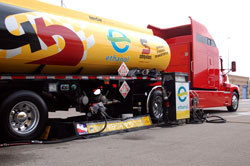The governor of Texas is asking the federal government to cut “skyrocketing” food prices by waiving half of the renewable fuel standard for ethanol made from grain.
Governor Rick Perry said in a statement that such a waiver was “the best, quickest way” to ease rising food costs before lasting damage was done.
 The Renewable Fuels Association criticized the governor’s action, saying that reducing the use of ethanol will not appreciably reduce grain prices for livestock producers and food processors in Texas.
The Renewable Fuels Association criticized the governor’s action, saying that reducing the use of ethanol will not appreciably reduce grain prices for livestock producers and food processors in Texas.
“But eliminating 4.5 billion gallons of fuel from the marketplace – as the 50% waiver of the Renewable Fuels Standard sought by Governor Perry would do – will increase gasoline and diesel prices even more. While this may benefit Texas oil companies, it will certainly hurt consumers in Texas and the rest of the country.”
RFA says that Governor Perry is ignoring the conclusions of a Texas A&M report he himself requested. According to the findings of that study, “relaxing the RFS does not result in significantly lower corn prices.” The Texas A&M report also stated that, “The underlying force driving changes in the agricultural industry, along with the economy as a whole, is overall higher energy costs, evidenced by $100 per barrel oil.”
According to RFA President Bob Dinneen, “Tampering, adjusting or removing the requirements will not have the impact on grain prices that Governor Perry seeks, nor will it bring the food price reductions he claims. The skyrocketing price of oil, surging global demand for grains and meat, poor harvests around the globe, and a weakened US dollar are the real factors determining world grain and food prices.”
 It’s a cold one out on the track at the Kansas Speedway today. I’m here covering the Roadrunner Turbo Indy 300. Fortunately, the clouds and mist are breaking up and a bit of blue sky is peeking through. Hopefully, that mean things will heat up. Right now it’s 45 degrees and that’s causing some delays. Official Indy rules require the thermometer to hit 50 degrees before cars are allowed on the track. The Indy Lights qualifications have already been canceled do to the chilly temperatures.
It’s a cold one out on the track at the Kansas Speedway today. I’m here covering the Roadrunner Turbo Indy 300. Fortunately, the clouds and mist are breaking up and a bit of blue sky is peeking through. Hopefully, that mean things will heat up. Right now it’s 45 degrees and that’s causing some delays. Official Indy rules require the thermometer to hit 50 degrees before cars are allowed on the track. The Indy Lights qualifications have already been canceled do to the chilly temperatures.

 An Irish renewable energy and sustainable waste management company has made a significant investment into a St. Louis-based wind energy company.
An Irish renewable energy and sustainable waste management company has made a significant investment into a St. Louis-based wind energy company.
 Missouri Governor Matt Blunt says don’t blame ethanol for the rising cost of food for people… or animals for that matter.
Missouri Governor Matt Blunt says don’t blame ethanol for the rising cost of food for people… or animals for that matter. Members of the European Biodiesel Board have asked the European Union to impose punitive tariffs on American biodiesel over complaints that U.S. subsidies on the green fuel are unfair. But their American counterparts at the National Biodiesel Board aren’t taking the threats lightly as they promise to hit back on what the NBB says are unfair trade barriers by the Europeans.
Members of the European Biodiesel Board have asked the European Union to impose punitive tariffs on American biodiesel over complaints that U.S. subsidies on the green fuel are unfair. But their American counterparts at the National Biodiesel Board aren’t taking the threats lightly as they promise to hit back on what the NBB says are unfair trade barriers by the Europeans. GM Vice President of Environment, Energy and Safety Policy Beth Lowery says the Lucerne, the first flex-fuel capable Buick passenger car, will be among more than 15 GM models with flex-fuel capability in 2009.
GM Vice President of Environment, Energy and Safety Policy Beth Lowery says the Lucerne, the first flex-fuel capable Buick passenger car, will be among more than 15 GM models with flex-fuel capability in 2009. “The state of Georgia is quickly becoming a recognized leader in alternative energy and fuel,” said Governor Perdue. “Our goal is to develop a bioenergy industry that provides substantial economic benefit to Georgia and produces 15 percent of the state’s transportation fuels by 2020 from locally produced biofuels.”
“The state of Georgia is quickly becoming a recognized leader in alternative energy and fuel,” said Governor Perdue. “Our goal is to develop a bioenergy industry that provides substantial economic benefit to Georgia and produces 15 percent of the state’s transportation fuels by 2020 from locally produced biofuels.” NCGA points to a
NCGA points to a  The
The  White and Cohen were in the position of defending biofuels. Leading in with a story that the Texas governor is calling for waiving half of the Renewable Fuels Standard to help cut food prices, White noted that there have been multiple studies, “including one from the great state of Texas this past month that clearly state that it’s energy prices, in particular petroleum prices, that are driving up food prices – three times as much as anything that commodity prices could do – ethanol just being one of those components of the corn market.”
White and Cohen were in the position of defending biofuels. Leading in with a story that the Texas governor is calling for waiving half of the Renewable Fuels Standard to help cut food prices, White noted that there have been multiple studies, “including one from the great state of Texas this past month that clearly state that it’s energy prices, in particular petroleum prices, that are driving up food prices – three times as much as anything that commodity prices could do – ethanol just being one of those components of the corn market.” The
The  The aim of the workshops is to promote direct marketing relationships between ethanol producers and fuel retailers and reduce costs for all parties involved. Ethanol plants, petroleum equipment suppliers, petroleum marketers and auto dealers are encouraged to attend these free workshops. Presentations will address E85 handling and storage, regulations and safety procedures, applying for the ethanol blender tax credit, and direct marketing of E85 from ethanol plant to retailer.
The aim of the workshops is to promote direct marketing relationships between ethanol producers and fuel retailers and reduce costs for all parties involved. Ethanol plants, petroleum equipment suppliers, petroleum marketers and auto dealers are encouraged to attend these free workshops. Presentations will address E85 handling and storage, regulations and safety procedures, applying for the ethanol blender tax credit, and direct marketing of E85 from ethanol plant to retailer.